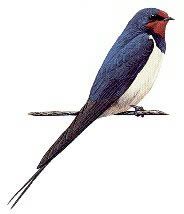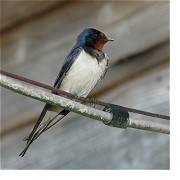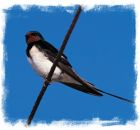| |
|
|
SEPTEMBER - SWALLOWS
One swallow might not make a summer, but you definitely won’t
find any swallows at all during the British winter. A sure sign that colder
weather is on the way is when football replaces cricket on the TV, and swallows
gather excitedly to leave Britain for warmer climes. As we look out our
gloves and scarves, and put the lawn mower into hibernation, our swallows
begin the 6,000 mile journey south to spend their winter in South Africa.
MIGRATION
One minute they are gathering together, both adults and young swallows
unmistakably excited about the unknown journey ahead. The next
the telephone wires and skies are empty as they leave us for another
year. We will see
some again next April or May, but many will never return. For
migration is a hazardous time and many birds die from starvation,
exhaustion and
during bad weather.
 Typically leaving us in September (the precise timing
of migration each year is governed by weather and food availability),
they travel through
western France, across the Pyrenees and down eastern Spain. Typically leaving us in September (the precise timing
of migration each year is governed by weather and food availability),
they travel through
western France, across the Pyrenees and down eastern Spain.
By
October, they have crossed the Mediterranean near Gibraltar and
reached Morocco.
Then begins the long journey across the Sahara Desert, continuing
south through Algeria, Niger and Chad to cross the Equator and
reach the Democratic
Republic of Congo in November.
Some birds prefer to follow the
longer west coast of Africa to avoid the Sahara Desert, while other
European swallows
travel further east and down the Nile Valley. They journey onwards
to arrive in South Africa just in time for Christmas. Migrating
swallows can cover
up to 200 miles a day, at speeds of about 20 miles per hour.
They migrate
during daylight at low altitudes and find food on the way. They don’t
put on much extra weight before migrating, so despite accumulating some fat
reserves before crossing large areas such as the Sahara, they are
very vulnerable to starvation.
Million of birds take flight each Autumn
as internal signals – triggered
by shorter days, waning food supplies and harsher weather herald
hard times to come. Prompted by climate and landmass changes at the end of
the last
ice age, this migration is at least 15,000 years old and still
evolving. The impacts of global warming on local environmental conditions
are already
influencing when and where some birds go. But general migratory
patterns are deeply ingrained and change takes time. Just how quickly migration
routes
will evolve to meet the future is still up in the air (excuse the pun!).
What’s remarkable is how they do it, navigating by an internal magnetic
compass and external markers – stars, mountains and rivers for example.
[Back to top]
RECOGNITION
 Swallows are distinctive birds and readily recognisable. They
are quite small with dark glossy blue backs, red throats, pale
under parts and notably long tail streamers.
Swallows are distinctive birds and readily recognisable. They
are quite small with dark glossy blue backs, red throats, pale
under parts and notably long tail streamers.
In flight, the swallow is
most agile and
graceful. Its effortless twisting and turning in search of food
is a delight to watch, and they spend most of the time in the air.
The
long tail is used
to good effect to accomplish intricate aerobatic manoeuvres to catch insects.
POPULATION
Results from recent surveys indicate that swallow numbers
have declined quite markedly in some parts of the country. There are
generally estimated to be around 375,000 breeding pairs in the UK, but
populations fluctuate from year to year and are affected greatly by weather.
They
require
rain for wet mud for nest building and for encouraging the abundance
of insect prey, but cold wet weather prevents them from feeding. Large
scale mortality is regularly recorded during and after bad weather, during
both
breeding and migration. On the other hand, hot and dry weather can result
in mortality through dehydration and heat stress.
Setting aside weather-related
fluctuations, there are believed to have
been widespread declines in Europe since 1970. The swallow is included
on the Amber List of Birds because of concern across Europe about its
conservation status. For more information, download "The State of the
UK's Birds, 2002" (PDF file, 749k), click
here.
Possible explanations for the decline include the following.
Climatic changes in the swallows African winter quarters and on migration
routes may be having a serious effect. Research has shown that swallows
are returning to their breeding areas in poor condition and are laying
fewer eggs than previously.
Adverse climatic conditions in Europe may also be having a detrimental
effect. Cold springs with late frosts in May and early June cause problems
for swallows, as do very hot summers. In the latter case, pools dry out,
reducing the numbers of emerging insects, and nestlings die from heat exhaustion
and dehydration.
The continuing spread of the Sahara Desert may be making this formidable
barrier increasingly difficult for swallows to cross.
-
Changes in farming practices throughout Europe may be reducing
the numbers of nest sites and flying insects.
If we are to conserve bird populations, then we need to
understand, among other things, how climate change might be affecting
migration strategies.
For more information, visit
the BTO Appeal website.
[Back to top]
ENCOURAGING SWALLOWS TO NEST:
We can do much to encourage swallows to nest, as they are
happy to live close to humans. For anyone with an interest in nature,
the pleasure of
seeing them close up every day is hard to beat.
They prefer outbuildings
which provide dark ledges and nooks and crannies for nesting. These
are cosy in cold weather and cool when it is hot. Swallows
can enter a building through a very small hole and need very little light.
Brightly lit nest sites are most at risk from predators. Pairs can occupy
the same building with nests as close as a yard apart.
To help them to
nest in a garage or outhouse:
Make a small opening, 50 mm high and 70 mm wide, under the garage or
barn eaves or leave a window or door open
Fix a nest platform where you would like them to nest, high in the
building, out of the reach of cats
Make a platform from four flat pieces of wood, or by fixing a sawdust
and cement or papier-mache cup to a wooden backing plate.
Put a plastic bag below the nest to catch droppings
Block off sites where you don’t want the birds to nest, for example
by attaching polythene to a beam, then to the roof and back to the beam again
If the weather becomes very hot, place an old carpet or blanket on
the outside of the roof above the nest and soak with water regularly. Just
a couple of buckets of bathwater on such fabric will take several hours
to dry and helps keep the temperature down inside.
[Back to top]
Links and Sources for this feature:
RSPB website
BTO website
Audio and video
How many swallows make a summer?
Birds of Britain website
RSPB swallow wildlife information leaflet (2002)
National Geographic
Magazine
[Back to top]
|
|


